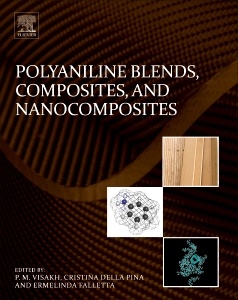Polyaniline Blends, Composites, and Nanocomposites
Coordonnateurs : Visakh P.M., Della Pina Cristina, Falletta Ermelinda

Polyaniline Blends, Composites, and Nanocomposites summarizes recent advances in polyaniline-based blends, composites and nanocomposites. Polyaniline (PANI) is a conducting polymer with a range of potential applications, particularly in electronics and packaging. The book covers the preparation, characterization and application of PANI-based composites, including the structure-property relationship and modification of PANI. It offers an in-depth update on the major findings and observations in the field of polyaniline-based blends, composites and nanocomposites, with contributions from leading researchers in industry, academia, government and private research institutions worldwide. The book is an application-oriented, practical guide to the development and application of this polymeric material.
The book includes discussion of reinforcement of polyaniline via addition of carbon-based materials, blends with thermoplastics, thermosets, natural and synthetic rubber, and polyaniline based composites and nanocomposites, with an emphasis on enabling polymer scientists and engineers to more effectively utilize this material in new applications.
1. Polyaniline based blends, composites and nanocomposites: State of Art, New Challenges and Opportunities 2. Polyaniline: Structure and properties relationship 3. Modification of Polyaniline 4. Reinforcements and Characterization of carbon-based Polyaniline composites 5. Nano/micro sized polyaniline materials based blends and composites 6. Polyaniline nano/micro materials based blends and composites 7. Nano and Micro patterning of Polyaniline 8. Polyaniline based blends: thermoplastic and thermoset 9. Polyaniline based blends: natural rubber and synthetic rubber 10. Polyaniline based composites and nanocomposites 11. Characterization of Polyaniline based blends, composites and nanocomposites 12. Polyaniline/natural polymers composites and nanocomposites 13. Biomedical application of Polyaniline based blends, composites and nanocomposites 14. Applications of Polyaniline based blends, composites and nanocomposites 15. Other applications of Polyaniline based blends, composites and nanocomposites
Cristina Della Pina was awarded the Master and Ph.D. degrees in Industrial Chemistry at the Università degli Studi di Milano (Italy) under the supervision of Prof. Michele Rossi. She is presently Associate Professor of Chemistry, Dipartimento di Chimica, Università degli Studi di Milano, CNR-ISTM. She is a member of the Editorial Board of the Journal of Advanced Catalysis Science and Technology, and co-author of the book ‘Polyaniline: From tradition to innovation’ with Nova Science Publishers. She has co-authored seventy scientific articles in peer-reviewed journals and one patent. Her research work focuses on the development and application of heterogeneous catalysts for the selective oxidation of organic compounds and conducting polymers.
Ermelinda Falletta received her master’s degree in organic chemistry at the University of Palermo. More recently, she has been researching new ‘green’ approaches to the preparation of new polymeric materials at the Dipartimento di Chimica, Università degli Studi di Milano, CNR-ISTM. She is the other co-author of ‘Polyaniline: From tradition to innovation’, and is the co-author of over thirty scientific papers.
- Includes an in-depth update on the state of research into this exciting material, with detailed and practical information for developing emerging applications of polyaniline
- Enables polymer scientists and engineers to overcome challenges and take advantage of opportunities relating to polyaniline, e.g., solubility of the polymer, improving conductivity and more
- Includes detailed coverage of the preparation, characterization and application of PANI-based composites in detail, along with the structure-property relationship and modification of PANI
Date de parution : 10-2017
Ouvrage de 358 p.
19x23.3 cm
Thème de Polyaniline Blends, Composites, and Nanocomposites :
Mots-clés :
Additives; Application; Applications; Blend; Blends; Cadmium sulfide; Carbon nanotube; Cellulose; Chitin; Chitosan; Chitosan-metal oxide; Composite; Composites; Corrosion; DBSA; Doping; Electrical conductivity; Electron beam irradiation; EMI shielding; Gamma irradiation; Ion implantation; Microstructure; Modified cellulose; Morphology; Nanocomposites; Nanoscale; Natural rubber; Organoclay; PANI; Polyaniline composite; Polyaniline; Properties; Starch and seaweed; Stress-strain property; Synthesis; Synthetic rubber; Thermal property; Zinc sulfide



